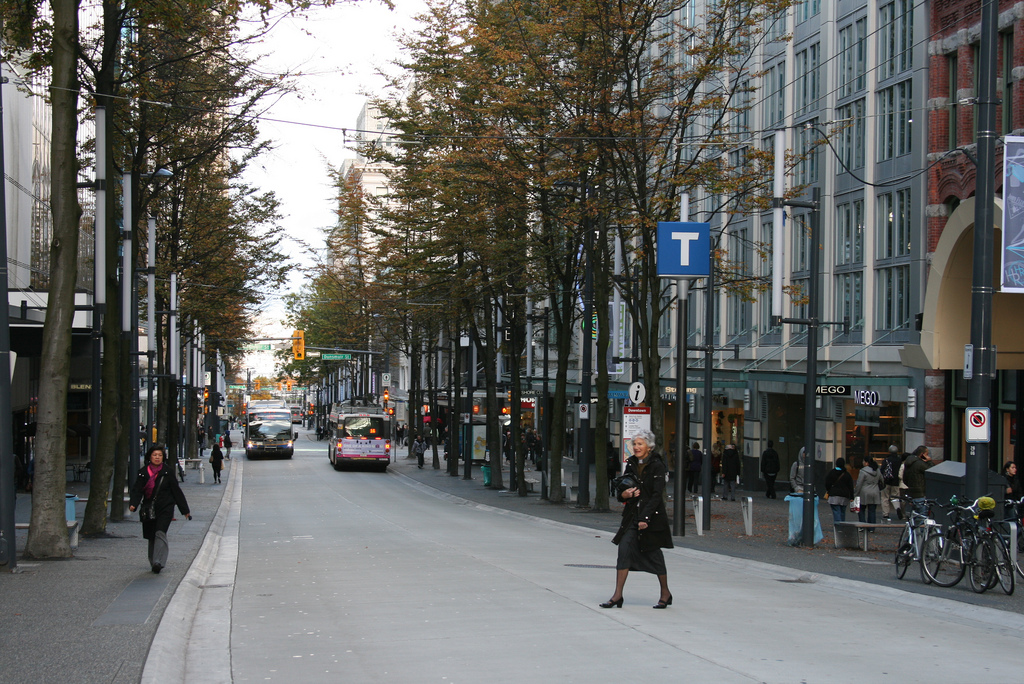Quote:
Originally Posted by J.OT13

Another consideration with Bank are the parking garage accesses and shipping/receiving bays. Closing down the street might not be realistic deepening on the number and locations of those. We also have to consider deliveries for the hundreds of businesses.
|
Just for context, north of the Canal, there are only two parking accesses from Bank. New entrances haven't been permitted for decades.
However, it's important to remember that eliminating congestion doesn't necessarily mean eliminating all traffic. The congestion clogging Bank isn't a convoy of delivery vehicles, accessible taxis, and cars heading to a business on Bank. A congestion-free Bank can exist with all of those.
Think of streets like Echo Drive in Ottawa, a popular walking and cycling route which, thanks to a few strategic vehicle restrictions, went from a highly-trafficked street to one which has rid itself of through-traffic without sacrificing local access.
Granville Street in Vancouver is another example of a street which manages to accommodate deliveries, taxis, and other local traffic, but without the kind of through-traffic that would cripple the city's bus spine.
Quote:
|
Access to Lansdowne is another important factor. Bank and Queen E. are the only two accesses. Queen Elizabeth Drive is often closed for active transportation.
|
Again, for context, QED has never closed at Lansdowne (for better or worse). It's also worth noting that Lansdowne is a very parking-lite site, containing only 1300 stalls, most of which are actually closed during major events, precisely to avoid overwhelming Bank. When you see 30 000-40 000 people in the stadium, remember that a maximum of 500 of them are using the parking.
Quote:
|
If we were only talking about local Bank (CBD to Lansdowne), than I would say surface should be discussed however, if we're looking at relieving the Confederation Line choke points at Hurdman and Bayview, where you may have a few thousand transferring on already packed trains. And if the Bank Subway extends down Rideau-Montreal, that makes the tunnel route (elevated south of the Rideau and east of St. Laurent) even further beneficial.
|
It depends whether this is meant as a crosstown line or not. If it is, as TrueNorth pointed out, it's not a useful line for anyone in the urban sections of Bank or Vanier, who skew much more heavily towards short trips, not long ones. For example:
Quote:
|
Yes, someone from Somerset might walk to the CBD, but if you live at Catherine, the subway is worth while.
|
...only barely. For the 1.2km to the CBD, the average journey by subway will take 13 minutes, vs 16 by foot. And that's assuming your origin and destination are within 200m of a station on either end. If they are even just a block and a half over, or if you just missed a train, you'd be faster to walk. Even so, it's a tough sell to ask $3.65 to save (potentially) 3 minutes. Even more to pay billions for the privilege.
Quote:
|
Sure the journey up and down the escalators will take a few minutes, but at least you're protected from the hot/cold in part, and increment weather. For me, once I get to the station entrance, I feel like I've arrived. The short journey down (if less than 20 meters) doesn't bother me.
|
Protection from the elements is very important. But you shouldn't have to choose between good transit trip times and weather protection. There are lots of things that can be done at grade to heat and cool passengers. It is important to remember however that, under or at-grade, this would be a high-frequency route. You probably wouldn't be waiting more than 2-3 minutes most of the day. In fact, the added distance between underground stations would mean that an underground system might actually require you to spend
more times in the elements, not less.
Quote:
|
The numerous traffic lights/intersections along Bank would slow down any tram network significantly. Reducing the number of intersections makes it harder for pedestrians to cross.
|
Bank doesn't have a lot of significantly-trafficked cross-streets. Really only four streets south of the core, the rest being local streets. If Bank were limited to transit vehicles, deliveries, and local traffic on two lanes, it would become significantly easier to cross on foot.
I'll go back to Vancouver's Granville Street, which is constantly being criss-crossed comfortably and safely by pedestrians. This elderly lady certainly doesn't appear displeased by the experience:




